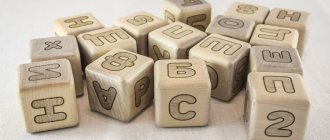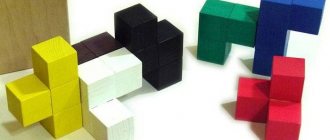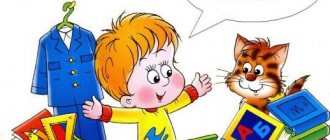How to teach a child to count?
IMPORTANT: Having decided to start teaching your child to count, you should have great patience. You can't shout or get nervous. The entire learning process should take place in a friendly, and, most importantly, playful atmosphere.
Starting from about two or three years old, you can teach a child to count to 10 , but it is better to divide this process into two stages.
At the very beginning, learn to count to 5 , and then to 10. This should be done in a playful way , counting together with the child his toys, surrounding objects, candies or fingers.
How to teach a child to count
It is mandatory, at the very beginning of mathematics, for the child to understand what is a lot or a little. You can put several toys on one side and only one on the other. For this you can use all surrounding objects. This also applies to such concepts as higher and lower, shorter and longer.
First method: While walking, it will be very fun to count trees, steps, birds, cars. You can even learn to count while dressing for the walk itself, putting one cap on your head and two socks on your feet.
Second method: You can count bright pictures in a book together with your child. Or you can draw and decorate balls or flowers yourself, and then count how many you got.
Third method: You should show your child that such knowledge is very useful. He can help set the table by arranging the required amount of cutlery.
Fourth method: Counting rhymes help very well in teaching counting. With their help, the child can easily and naturally remember a decent score.
We work with accounts
A child should be taught to count to ten before he enters school.
Then you need to develop computational skills. This can be done on your fingers or matches. Many experts advise using abacus. Such devices do not interfere with adding or subtracting numbers in the mind. Today, every person has a calculator at home. This device makes life easier, but does not develop mathematical and logical thinking. Therefore, you should not teach your child to use gadgets.
So the child will never learn to perform simple mathematical operations in his mind. Abacus should be used from the age of three. With such a device, you can teach your child to count to 10, 20, 100, and complicate the tasks as they master the material. This product develops fine motor skills and manual dexterity well.
Training in working with accounts should be based on the following algorithm:
- set number . Align the knuckles to one edge. This location means zero. The bottom row is hundredths, the second row is tenths, the third is quarters. Next are units, tens, hundreds, thousands. To dial a number, move a certain number of dominoes to the other side;
- addition _ Dial the first term on the abacus, and then the second, moving the required number of dominoes to the side, starting from the bottom row;
- subtraction . All actions are carried out similarly to addition, but from top to bottom.
Video: Counting - Learning to count from 1 to 10 with a song
IMPORTANT: Activities should arouse interest in the child. If the mother notices that the baby is bored, or such lessons cause him discomfort, he should postpone training for a few days.
During the learning process, you should pay attention to simple geometric shapes. Just like learning to count, the whole process should take place in a playful way and using the example of surrounding objects.
IMPORTANT: Having learned to count to ten, you can move directly to the numbers, explaining to the child, with the help of pictures and objects, exactly how many objects represent a particular number.
Teachers do not advise introducing your child to the number 0 before he learns to count to 10 well.
How to teach a child to count
IMPORTANT: The child should not forget to praise and thereby encourage him to further success.
After your child has learned to confidently count to 10, you can begin to learn to count to 20 . As in the first case, you should start with simple examples, explaining to the child that after the number 11 comes the number 12, and after 12 comes 13. And so on.
In order to teach a child to count to 100, mom and dad should have great patience . Just gradually and slowly teach the child every ten.
IMPORTANT: You cannot squeeze knowledge out of a baby just because the neighbor girl is counting almost out of diapers. Each child is individual and requires a special approach.
Where and when to start?
It is possible to begin learning mental arithmetic as early as 2–3 years of age, gradually increasing the complexity of the tasks. The main thing is to count while playing. For example, when collecting cubes or pyramids, say: “Put the first cube (first ring), and the second one on top. Look, there was only one cube, now there are 2 of them.”
In a playful way, a child’s natural interest awakens and he learns easily. It must be remembered that a child of primary preschool age remembers only what is interesting to him. The game will be the best way for this. The main thing here is the location and support of the parents, their ability to interest the baby in the process. And behind this the desired result will come.
At 3–4 years old, you can count the buttons while buttoning your jacket, the number of spoons of porridge that the baby ate for breakfast, the number of plates or spoons on the table, the number of steps up to the entrance door, etc. While walking, you can count cars (if you count only red or white, you can also attach the name of the flowers), cats or lanterns. You can count in the store how many apples, yoghurts or something else you bought; while cooking, you can count the number of products your mother takes.
Visualization of the count is also facilitated by cards depicting the number of objects and numerical designations. By playing with them, you can teach your child to understand, for example, that the number 3 is 3 apples. That is, the baby will learn to correlate the quantity and its numerical image. Such cards can be made independently and used starting from 4 years old.
Using cards, educational aids or toys, you can explain to your child the composition of a number. That is, 5 bunnies can be obtained by adding 2 and 3, 1 and 4, or 3+2, 4+1. In this case, the terms were swapped, but the result remained the same. This is necessary to teach the child to solve simple examples. By the way, children learn to add or subtract within ten just fine using regular coins. For example, counting how many coins you need to buy candy. At 5–6 years old, a preschooler will be happy to add numbers on car license plates (say, 135 is 1+3+5).
Another way to reinforce this understanding (as well as the more-less, one-many relationship) is the game of store. The child is nominated by the seller. “Goods” (fruits, vegetables, toys, books) are laid out on the table, assigning each of them a price tag card indicating a specific number. For example, an apple costs 2 coins (you can come up with your own name for the currency - it will only be more interesting). Then the baby will have to count his mother's purchases and calculate how much money they cost.
Mom may say: “I have 3 apples. I need 1 less pear.” Or: “I take 2 yoghurts. I need an equal amount of yoghurt and cookies.” You can develop this game as your parents’ imagination dictates, asking a wide variety of questions, studying not only counting, but also simple calculations. The main thing is that the child finds it interesting to count.
How to teach a child addition and subtraction?
Only when the child can already count to 10 can he start adding . To do this, you can use both toys and apples or other objects that interest the child.
EXAMPLE: Place one item on the table, and then add another one to it. In this case, it is necessary to explain to the child that one plus one equals two. Then you should add one more to these two objects, explaining to the child that one plus two equals three. Don’t forget to explain that two plus one also equals three.
Do not overload your child with information. You should gradually , as the baby perceives it, learn from more complex examples. The material covered should be reinforced with repetitions .
IMPORTANT: Parents must voice their every action, without this the child will not be able to understand what they want from him.
Methods of teaching counting
How to start teaching your child to count to 10? There are several techniques that are best used at the start of the learning process:
- Fingers. They are always available and in sight, so this is a proven method. To begin with, you can familiarize your baby with the name of each of the fingers. Then you can go directly to the counting, but within one hand. When the baby can count five fingers well, you can connect the second pen.
- Items. After the fingers, you can move on to objects. Fingers alone are not enough to fully master counting, because the baby may begin to associate numbers with elements of his palm, which will create difficulties in further learning. As arithmetic materials, you can use cubes, baby dolls or dolls, balls, cars, children's dishes, various fruits, candies, stones or shells.
- Abacus. Some consider this device to be outdated, but it can be very useful in teaching counting, because individual elements are always in sight and nearby, and it is also convenient to move them along the twigs for ease of counting.
- Sticks or cards. But it is advisable to use educational materials of the same color so that different shades do not distract the child from the main thing - counting. It is recommended to choose a bright, but not too catchy color scheme, for example, green, blue, yellow, red, orange. Such colors attract attention, help you concentrate and not be distracted by other surrounding objects.
- Educational videos, educational cartoons. Today there are a lot of such materials, including those with favorite children's characters. Watching a cartoon teaching counting will certainly be enjoyable and useful. The video should be of high quality, attract attention and not too long - no more than 10-15 minutes. For a longer period of time, the baby simply will not be able to maintain attention.
- Author's methods. For example, the world-famous teacher Maria Montessori recommended using the most obvious and vital example - money. First, you can take ordinary coins and count them individually, and only then master the denominations, fold them, exchange them, and imitate shopping situations in stores. Another technique was developed by Glen Doman, and he proposed using cards with dots, the number of which corresponds to different numbers, as training material. This format is more familiar to children: they do not think abstractly, but connect and associate counting with specific objects. The author suggested showing the child 5 images three times a day. The next day you need to remove the first two cards, adding two new ones. There are a total of 100 pictures in the system with the number of dots (circles) from 1 to 100.
- Games. There are many of them, so you will find an option suitable for a particular child. The different games are discussed below.
Video: Mathematical counting rhyme. Poems for adding and subtracting units. Our_everything!
When the child understands the entire process of addition, you can begin subtraction. to count backwards before learning subtraction , so it will be easier for him to master new information.
IMPORTANT: An excellent example would be if you put two apples on the table and then take one away. The child must say how many apples he has now. Children are great owners and will remember such examples well.
As with teaching counting, all mini-lessons should only be taught in a positive mood and with interesting examples . The manuals will help you cope with the task at hand. These can be either books or notebooks. But their choice should be taken with great responsibility.
The game is the best way to teach a child to count
Rules
Finally, we will give parents recommendations that will help teach their child to count effectively and calmly:
- Together with your daughter or son, count everything you see around you: birds, steps you climb, steps.
- Say numbers often in normal everyday situations. Tell us what floor you are going up to, how many yoghurts you bought in the store, how many cats or birds you saw on the way home.
- Keep it interesting. Engage, use different methods, conduct classes in a relaxed and fun way.
- Repeat materials already covered more often so that your child does not forget them.
- At the first stages of learning, use counting rhymes. They are well remembered and help to master numbers.
- You can enroll your child in developmental classes. A professional teacher will certainly be able to find an approach to each specific child, attract his attention and choose a suitable teaching method.
- If your child attends kindergarten, ask the teacher what classes are offered and which ones are interesting to your son or daughter.
Are you planning to master counting to 10 with your baby? The methods, rules and tips from this article will certainly help you start and successfully continue your training. Patience and success to you and your children!
How to teach a child to count in his head?
IMPORTANT: Until about 4-5 years of age, there is no point in forcing a child to count in his head; the child’s brain is not yet able to cope with such a task.
In order for a child to learn to count in his head , it is necessary:
- So that he can count well
- Know the numbers
- Distinguish where there are more objects and where there are less
- Knew what an equal amount was
IMPORTANT: Even if a child has easily mastered all the basics of mathematics, you cannot expect instant results from him.
How to teach a child to count in his head
- You can ask your child to count the number of objects out loud, but as quietly as possible
- You should gradually stop using foreign objects and fingers.
- Ask your baby to move his lips only slightly
IMPORTANT: If you practice mental arithmetic every day in a fun way, then after a while the child will be able to independently solve more complex examples of addition and subtraction.
Mental arithmetic is not only an important aspect of mathematics, it has a positive effect on a child's development. Several times a day , as if between times, you should give your child easy tasks.
IMPORTANT: Do not rush your child or solve the task for him. If the child does not want to answer at this moment, you should postpone the lesson for a while.
Stages of training
The process of mental arithmetic in children consists of two components: speech and motor.
The speech component is expressed in pronouncing counting actions, then in whispering (one plus one equals two). And only after this the child will be ready to count “with his eyes”, silently.
The motor element consists of rearranging the objects being counted. This is how the child visualizes whether there are more or fewer objects. At first, the baby follows the emerging objects with his finger, then only with his eyes. And only then will he be ready to count in his head: first to 5, then to 10, and so on.
Thus, in order to teach a child to count mentally within tens, you need to combine rearranging objects with memorizing this number. And the child needs to be prepared for this.
At the very beginning, a preschooler needs to be taught:
- realize the difference between the concepts “one” and “many”;
- understand what “more”, “less”, “the same” (equal) means;
- distinguish between ordinal (first, second) and quantitative (one, two) counting;
- understand what the composition of a number is (for example, that 4 is 2+2, 3+1);
- associate a quantity in your mind with its written numerical expression (that is, understand that 5 carrots are denoted by the number 5).
Considering the visually effective way of thinking of young children, these concepts need to be explained using specific objects. Better - the baby’s favorite bright toys, allowing him to move them during the game to make them equally, more, less, a lot. The ability to compare quantities will help you quickly master mental calculation.
The initial stage of mastering mental counting is learning to count first to 5, then to 10. Next, you need to help the child remember all the results of adding and subtracting the numbers of the first ten. Preschoolers will then be able to learn ways to perform these operations in their minds with two-digit numbers. The main thing here will be to teach the child to understand and remember the method of addition and subtraction in the next tens.
At each stage, it is not mechanical memorization that is important, but understanding and remembering each step.
When you start solving simple problems with your child, try to offer him several solutions, if possible. This will develop mathematical flexibility and facilitate learning in later stages.
Game for children: learning to count
At first glance, learning to count is very difficult, but as you play, everything complex becomes quite simple.
IMPORTANT: You cannot insist and force your child to play.
To play you will need:
- Dice
- Small cubes or sticks, you can use shells, nuts, pebbles
- Two containers where items will be placed
The essence of the game:
- Baby and mom take turns throwing the dice
- After the throw, together they count the value rolled and take a certain number of objects into their cup.
- The winner is the one who fills his container the fastest
You can gradually make the game more difficult by adding another die and more items. If the child has already learned to count well, you can ask him to write down the resulting number on a piece of paper.
Game for learning to count
Lotto games or number counter games will help you quickly learn numbers. You can, of course, use computer educational games in teaching, but you should not resort to this method too often. There is nothing better than parents and child playing together
Learning to count money
You can start teaching children financial literacy from the age of 6-7 years. It is necessary to tell the child about the denomination, to give an understanding that each bill and coin has its own value.
It is necessary to explain how many kopecks are in a ruble, the difference between metal and paper money. Training must be visual.
It is recommended to play “Seller-Buyer” with your baby. To do this, you should simulate the situation of selling and buying bottles, toys, and juice boxes. It's better to use real money. It is useful to go shopping together with your baby.
Addition and subtraction games
IMPORTANT: You can teach your child addition and subtraction through play. We need to start with the simplest things. If the child does not succeed, you should help and explain to him again what is required of him. The game should bring only pleasant emotions.
Dwarves on a walk
Required for the game:
- Cubes
- Box or other container for cubes
Progress of the game:
You should invite the child to imagine that the cubes are forest gnomes. In the evening they go into the box house, and in the morning they go for a walk.
- The child needs to count how many gnomes live in the house
- The baby turns away, and the adult takes one or more cubes, voicing this number to the child
- He must first tell himself how many gnomes are left, and then count them in the box
In the same way, you can add cubes, as if the gnomes had returned from a walk.
Playing together is the best way to learn addition and subtraction
Shop
To play you need:
- Toys that will be sold
- Substitute money, candy wrappers
Progress of the game:
- Each toy should have a price tag attached to it.
- Give your child the required amount of candy wrappers
- A child comes to the store to make a purchase, he should count how many candy wrappers he has, more than the indicated price on the price tag or less
- Subtract the required number of candy wrappers from the total amount and announce how many of them he has left
During the game you can change places , then the baby should:
- Name the price of each toy
- Calculate whether he was given the correct number of candy wrappers, if he needs to return the excess, or ask for more candy wrappers
- Add candy wrappers for one purchase to candy wrappers for another and tell their total amount
IMPORTANT: Parents themselves can come up with games, the main thing is that the child shows interest in them and enjoys exploring the world of numbers and numbers.
Mastering simple mathematical operations
In order to learn to add and subtract well, a child must manipulate the same homogeneous objects, relating them to the representation of each number. This helps to include the preschooler’s visual and tactile memory to remember the results of actions with whole number groups, and not by unit. Therefore, at this stage, all kinds of dissimilar objects or toys are no longer suitable. It is better to replace them with simple and understandable cubes.
To begin with, you will need 5 cubes, a box with marked cells for them, and cards depicting numbers from 1 to 5. The location (configuration) and number of cubes are stored in the preschooler’s memory, which is not the case when working with sticks or fingers - they are located chaotically, not giving visual ideas about a certain “number configuration”. Therefore, a specific “computational picture” will not be deposited in the child’s head.
The child is asked to put 1 cube in the box, asking how much it is. If the answer is “one,” he must place a card with the number 1 next to the cube. Then he adds the second cube. Says: there are 2 cubes, changes the card with the image of one to the card with the image of two. After repeating the manipulation several times, the baby will remember the image of two cubes and will then name their number at once, without counting. The rest of the numbers are taught to count in the same way.
Next, we teach addition and subtraction directly. The child needs to be told that the blocks are, for example, funny clowns, and the cells in the box are their houses. Now let's populate one clown. How many clowns will there be if another one comes? Two. How many will remain if one leaves? - One. And so on.
With the help of such a simple technique, a preschooler will quite successfully master mental counting skills and simple mathematical operations. And this, as already mentioned, is useful not only for future mathematics lessons.










